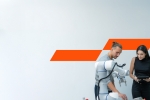These developments have driven up the ultimate losses, but the question remains whether the current estimates are accurate. Given the interdependence of internal processes at insurers, both underestimation and overestimation of ultimate losses can cause problems, for example in pricing processes. Therefore, accurately estimating bodily injury claims is crucial.
Use of GenAI and LLMs
Risk modelling specialists Michel Abbink and Lars Janssen from PwC advocate for the use of Generative Artificial Intelligence (GenAI) and advanced language models (Large Language Models, LLMs) to improve the available data. ‘This data can then be used by statistical models for more accurate reserving. Although statistical reserving methods are promising, actuaries face challenges such as complex data structures, inconsistent data quality, and limited availability of information, especially in the early stages of a claim. Therefore, robust data controls and processes are needed to ensure the quality and reliability of statistical reserving methods,’ says Janssen.
Market benchmark for statistical reserving
PwC previously conducted a global market benchmark on bodily injury reserving by interviewing experts. ‘The research focused on mapping the current best practices in the use of traditional methods, statistical models, and individual reserving for determining the claims provision,’ continues Abbink.
‘This benchmark showed that most insurers strive for a data-driven approach. Statistical models are generally used to support claims handlers or actuaries, rather than being applied directly as the primary reserving method. For example, statistical models help in determining case reserves for large bodily injury claims using extensive medical data.’
Unlocking early claim data
‘A challenge in applying statistical reserving models is the (un)availability of accurate data in the early stages of the claim lifecycle,’ says Janssen. ‘Early available data often lacks the predictive value for loss components, such as loss of earning capacity. The data available at an early stage is often unstructured and consists of notes from claims handlers, legal documents, and correspondence. This leads to various challenges and opportunities for improvement.’
Various challenges and opportunities for improvements
Improving data quality with GenAI
GenAI can significantly improve the quality and consistency of data in bodily injury claims handling. By automatically capturing and filling in structured information from unstructured sources such as emails, conversation reports, and notes from claims handlers, GenAI streamlines the process. This reduces the workload of claims handlers, allowing them to focus on more complex and valuable tasks.
However, it is important to recognise that the implementation of GenAI can cause changes in the claims handling process,’ says Janssen. ‘Changes in these processes can cause trend changes, making future development patterns no longer comparable with previous analyses. In the past decade, various changes have occurred in the Dutch market, leading to an increase in uncertainty in reserves and pricing.’
Abbink and Janssen recommend that insurers evaluate GenAI methods that complement existing claims handling processes rather than change them. ‘This can be achieved by having Finance and Actuarial teams perform additional analyses without changing the processes of claims handlers,’ continues Abbink.
Embracing AI for a competitive advantage
In a rapidly evolving insurance landscape, the integration of AI technologies such as GenAI and LLMs is becoming increasingly essential. ‘Actuaries who embrace these developments will not only improve the accuracy and efficiency of their reserving processes but also position themselves at the forefront of innovation in the industry. Large insurers with substantial funding and resources can implement these changes and continuously refine processes. Small and medium-sized insurers must ensure they implement these changes correctly the first time. The future of the insurance sector depends on the ability to adapt and leverage these new technologies,’ concludes Janssen.


















